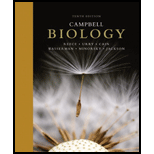
(a)
To create: A data table for all sampling sites by estimating the frequencies of lap94 allele using a pie chart.
Introduction: Mytilus edulis also known as marine blue mussel is found along the coastal line of the Northern Atlantic Ocean, including Europe, North America, and the Northern Palearctic. It is adapted to high salinity environment due to the presence of a locus for a particular allele, lap94. Lap (leucine amino-peptidase) cleaves the n-terminal amino acids from short peptides and releases free amino acids to the cytosol and thus regulates the mussel’s internal saltwater balance through osmoregulation.
(b)
To draw: A graph representing frequencies for sites 1-8 with respect to increasing salinity in Long Island Sound and to compare the data of sites 9-11 to the data from sites within the Sound.
Introduction: Mytilus edulis also known as marine blue mussel is found along the coastal line of the Northern Atlantic Ocean, including Europe, North America, and the Northern Palearctic. It is adapted to high salinity environment due to the presence of a locus for a particular allele, lap94. Lap (leucine amino-peptidase) cleaves the n-terminal amino acids from short peptides and releases free amino acids to the cytosol and thus regulates the mussel’s internal saltwater balance through osmoregulation.
(c)
To construct: A hypothesis to explain (1)the maintenance of mussels osmotic balance in high salinity environment by lap94 allele but is costly to use in less salty water and (2) long distance dispersal of mussels larvae before their settlement on rocks and grow into adults.
Introduction: Mytilus edulis also known as marine blue mussel is found along the coastal line of the Northern Atlantic Ocean, including Europe, North America, and the Northern Palearctic. It is adapted to high salinity environment due to the presence of a locus for a particular allele, lap94. Lap (leucine amino-peptidase) cleaves the n-terminal amino acids from short peptides and releases free amino acids to the cytosol and thus regulates the mussel’s internal saltwater balance through osmoregulation.
Want to see the full answer?
Check out a sample textbook solution
Chapter 23 Solutions
Campbell Biology (10th Edition)
- What are the roles of DNA and proteins inside of the cell? What are the building blocks or molecular components of the DNA and proteins? How are proteins produced within the cell? What connection is there between DNA, proteins, and the cell cycle? What is the relationship between DNA, proteins, and Cancer?arrow_forwardWhy cells go through various types of cell division and how eukaryotic cells control cell growth through the cell cycle control system?arrow_forwardplease make the drawing and steps of whats it asking. thank you!arrow_forward
- please fill in empty spots. thank you!arrow_forwardplease fill in the empty sports, thank you!arrow_forwardIn one paragraph show how atoms and they're structure are related to the structure of dna and proteins. Talk about what atoms are. what they're made of, why chemical bonding is important to DNA?arrow_forward
- What are the structure and properties of atoms and chemical bonds (especially how they relate to DNA and proteins).arrow_forwardThe Sentinel Cell: Nature’s Answer to Cancer?arrow_forwardMolecular Biology Question You are working to characterize a novel protein in mice. Analysis shows that high levels of the primary transcript that codes for this protein are found in tissue from the brain, muscle, liver, and pancreas. However, an antibody that recognizes the C-terminal portion of the protein indicates that the protein is present in brain, muscle, and liver, but not in the pancreas. What is the most likely explanation for this result?arrow_forward
- Molecular Biology Explain/discuss how “slow stop” and “quick/fast stop” mutants wereused to identify different protein involved in DNA replication in E. coli.arrow_forwardMolecular Biology Question A gene that codes for a protein was removed from a eukaryotic cell and inserted into a prokaryotic cell. Although the gene was successfully transcribed and translated, it produced a different protein than it produced in the eukaryotic cell. What is the most likely explanation?arrow_forwardMolecular Biology LIST three characteristics of origins of replicationarrow_forward
 Human Anatomy & Physiology (11th Edition)BiologyISBN:9780134580999Author:Elaine N. Marieb, Katja N. HoehnPublisher:PEARSON
Human Anatomy & Physiology (11th Edition)BiologyISBN:9780134580999Author:Elaine N. Marieb, Katja N. HoehnPublisher:PEARSON Biology 2eBiologyISBN:9781947172517Author:Matthew Douglas, Jung Choi, Mary Ann ClarkPublisher:OpenStax
Biology 2eBiologyISBN:9781947172517Author:Matthew Douglas, Jung Choi, Mary Ann ClarkPublisher:OpenStax Anatomy & PhysiologyBiologyISBN:9781259398629Author:McKinley, Michael P., O'loughlin, Valerie Dean, Bidle, Theresa StouterPublisher:Mcgraw Hill Education,
Anatomy & PhysiologyBiologyISBN:9781259398629Author:McKinley, Michael P., O'loughlin, Valerie Dean, Bidle, Theresa StouterPublisher:Mcgraw Hill Education, Molecular Biology of the Cell (Sixth Edition)BiologyISBN:9780815344322Author:Bruce Alberts, Alexander D. Johnson, Julian Lewis, David Morgan, Martin Raff, Keith Roberts, Peter WalterPublisher:W. W. Norton & Company
Molecular Biology of the Cell (Sixth Edition)BiologyISBN:9780815344322Author:Bruce Alberts, Alexander D. Johnson, Julian Lewis, David Morgan, Martin Raff, Keith Roberts, Peter WalterPublisher:W. W. Norton & Company Laboratory Manual For Human Anatomy & PhysiologyBiologyISBN:9781260159363Author:Martin, Terry R., Prentice-craver, CynthiaPublisher:McGraw-Hill Publishing Co.
Laboratory Manual For Human Anatomy & PhysiologyBiologyISBN:9781260159363Author:Martin, Terry R., Prentice-craver, CynthiaPublisher:McGraw-Hill Publishing Co. Inquiry Into Life (16th Edition)BiologyISBN:9781260231700Author:Sylvia S. Mader, Michael WindelspechtPublisher:McGraw Hill Education
Inquiry Into Life (16th Edition)BiologyISBN:9781260231700Author:Sylvia S. Mader, Michael WindelspechtPublisher:McGraw Hill Education





